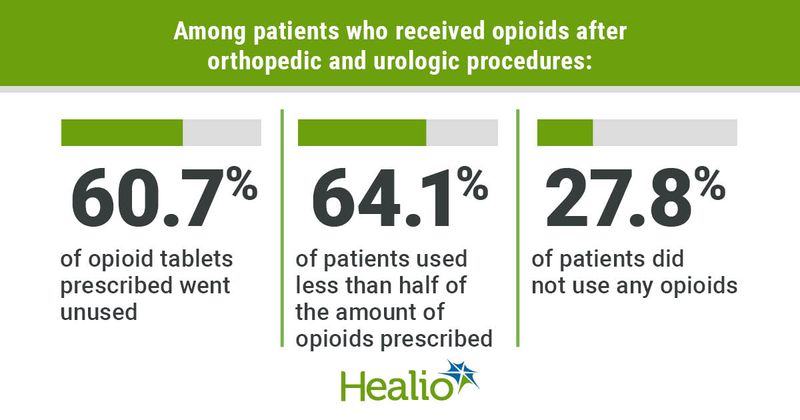Patients consumed fewer opioids than prescribed after orthopedic, urologic procedures
Patients who underwent orthopedic and urologic surgical procedures reported consuming fewer opioids postoperatively than the quantity prescribed, according to published results.
Anish K. Agarwal, MD, MPH, MS, and colleagues used an automated text-messaging system to collect the difference between the number of opioid tablets prescribed and the patient-reported number of tablets taken among patients who underwent orthopedic (n=742) and urologic (n=177) procedures. Researchers also collected patients’ self-reported pain intensity and ability to manage pain after orthopedic and urologic procedures.

Results showed patients had a mean pain score of 4.72 and 3.48 on postoperative day 4 after orthopedic and urologic procedures, respectively. Researchers found patients had a mean change in pain score of –0.40 for orthopedic procedures and –1.50 for urologic procedures by postoperative day 21. On postoperative day 4, patients had a mean ability to manage pain score of 7.32 for orthopedic procedures, with a mean change of –0.80 by day 21, according to results. Researchers noted patients who underwent urologic procedures had a mean ability to manage pain score of 7.34 on postoperative day 4, with a mean change of 0.80 by postoperative day 14.

According to researchers, patients who underwent orthopedic and urologic procedures received a high median quantity of opioids compared with self-reported consumption. Overall, researchers found 60.7% of opioid tablets prescribed went unused during the study period. Results showed 64.1% of patients used less than half of the number of opioids prescribed and 27.8% of patients did not use any opioids.
“The gap between the number of opioids being prescribed for common orthopedic surgeries and what patients use persists. This research and quality improvement work highlights the ability to use a scalable text-messaging program to connect with patients, gather data and provide surgeons with procedure specific information to help guide tailored prescribing and effectively manage patients,” Agarwal told Healio Orthopedics. “Future research will investigate how to incorporate these data into clinical guidelines, within the electronic health record and to inform patient-centered shared decision- making.”

